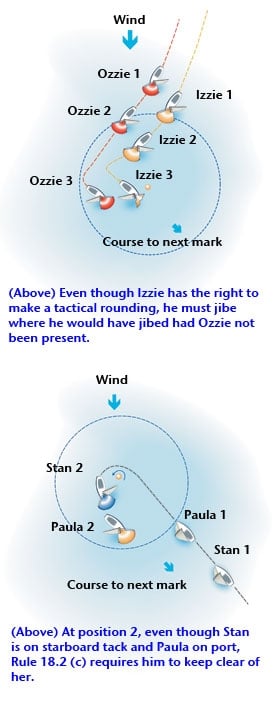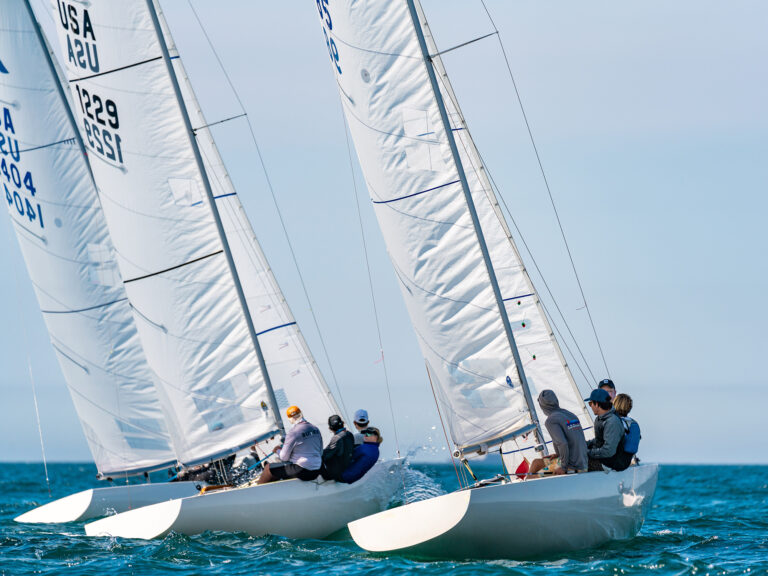
NovRulesRose
Last month I discussed how the rules apply when you tack near a mark. This month I’ll discuss how the rules cover a jibe near a mark. The preamble to Rule 18 contains an important principle. Whenever jibing is a “normal part of the manoeuvre” of rounding or passing a mark, room for that maneuver includes room to jibe. Room is defined as “the space a boat needs in the existing conditions while manoeuvring promptly in a seamanlike way.” ISAF Case 103 tells us the phrase “seamanlike way . . . refers to boathandling that can reasonably be expected from a competent, but not expert, crew . . .”
Note that in big seas and strong winds some boats handled in a seamanlike way may need a surprisingly large amount of space to jibe. Older designs with undersized rudders or with bluff bows will not always bear off at the moment that the helmsman wishes to jibe. If a wave is pushing to windward on a boat’s leeward topside near her bow, she may not be able to bear off, even with her helm hard up, until the wave has passed.
The first diagram shows a common situation at a jibe mark to be left to port. Let’s assume the wind is light enough that boats can jibe whenever they wish. When Izzie reaches the two-length zone, she has an inside overlap on Ozzie. Five rules apply until Izzie jibes. Rules 11 and 18.2(a) require Ozzie to keep clear of Izzie. Rule 18.4 states that until Izzie jibes “she shall sail no farther from the mark than needed to sail [her proper course].” Rule 18.2(d) permits Izzie to bear away to round the mark as rapidly as she pleases without any constraint on her turn from Rule 16.1. Ozzie has to sail a longer track outside Izzie and so it is quite possible that he will fall clear astern during the rounding. In that case Rule 18.2(b) requires that Ozzie must continue to give Izzie room, must also keep clear of Izzie, and, if he manages to sail into an inside overlap on Izzie, is not entitled to room.
Suppose the next leg is a tight spinnaker reach and Izzie wants to be as close as possible to the mark as she completes her rounding. Her proper course is the course she would sail if she were rounding by herself without Ozzie present. In that case, she would sail wide of the mark initially and then, after her jibe, luff up quickly. So, even though Izzie has right of way at position 2, Rule 18.4 requires her to bear off and jibe at that time.
Izzie jibes, luffs quickly, and then her spinnaker collapses, allowing Ozzie to maintain an outside overlap. After her jibe, Izzie loses some rights. Rule 11 gives Ozzie right of way as the leeward boat, and Rule 18.2(a)’s requirement that Ozzie keep clear of Izzie ceases to apply. Rule 18.2(d) gives Ozzie the right to complete his rounding as rapidly as he wishes, but he continues to be required by Rule 18.2(a) to give Izzie room to round. Finally, Rule 18.4 stops applying when Izzie jibes.
Let’s move on to our next situation: Suppose a fleet is approaching a windward mark to be left to port, and the port side of the run is favored. Boats will be on starboard tack as they pass to windward of the mark, and some boats will opt for a jibe set of their spinnakers. U.S. Racing Rules Committee member Art Engel recently pointed out to me that this common situation results in tricky rule questions. The second diagram shows such a situation.
At position 1, Paula and Stan are both sailing closehauled on starboard on the layline, with Paula clear ahead when she reaches the two-length zone. Paula decides to jibe set, while Stan chooses simply to bear off on starboard while setting his spinnaker. Paula’s crew is slow to ease the main and so she does a wide, slow rounding before jibing onto port tack. Stan rounds cleanly, bears off and heads directly for Paula’s stern. At position 2, Stan finds that he must luff to avoid having his spinnaker touch Paula’s backstay. He avoids the contact and hails “Protest.” How would you decide this protest?
Let’s assume the facts are as stated above and shown in the second diagram. What rules apply? As the boats approach the zone, Rule 12 requires Stan-the boat clear astern-to keep clear of Paula. At position 1, when Paula reaches the zone, Rule 18.2(c) begins to apply. It grants Paula very strong rights, the most important of which is that Stan must keep clear of her “thereafter,” i.e., from the time she reaches the zone until Rule 18 ceases to apply. Rule 18.1 states Rule 18 ceases to apply when both boats have “passed” the mark. The word “passed” does not appear in italics and is not a nautical term. Therefore, it is “used in the sense ordinarily understood in general use” (see Terminology in the Introduction to the rulebook). My dictionary suggests that the boats have “passed” the mark when they are both beyond it, i.e., when it is astern of each of them.
As the boats round the mark, Rule 12 continues to apply until Paula jibes. At that moment, the boats are on opposite tacks and normally Rule 10 would require Paula to keep clear of Stan. However, Rule 10 is in direct conflict with Rule 18.2(c)’s requirement that Stan keep clear of Paula. The preamble to Section C of Part 2 of the rules resolves this conflict. The preamble to Section C states, “To the extent that a Section C rule conflicts with a rule in Section A . . . the Section C rule takes precedence.” Rule 18 is in Section C, and Rule 10 is in Section A. Therefore, at position 2, Rule 18.2(c) takes precedence over Rule 10, and Stan, who has not quite passed the mark, is required to keep clear of Paula. Stan luffed and avoided contact. Therefore, Stan met his obligation to keep clear of Paula; his protest should be disallowed and neither boat should be penalized.
The rules protect a boat that, like Paula, wants to jibe onto port tack at the windward mark, but only if she jibes before any boat behind her has passed the mark. If Paula had delayed her jibe until both she and Stan had passed the mark, Rule 18.2(c) would not have applied when she jibed. In that case, Rule 10 would have begun to apply when Paula jibed, and, if Stan had found it necessary to luff to avoid Paula, she would have broken Rule 10. (Rule 15 would not have applied after Paula’s jibe because Stan would have acquired right of way due to Paula’s actions.)
The lesson to be learned here is this. If you are approaching a windward mark and wish to jibe onto port to get to the port side of the run, you should jibe right at the mark while Rule 18.2(c) still protects you. If you jibe later, then you must make sure that you can keep clear of any starboard-tack boats behind you after you jibe.
E-mail for Dick Rose may be sent to rules@sailingworld.com









